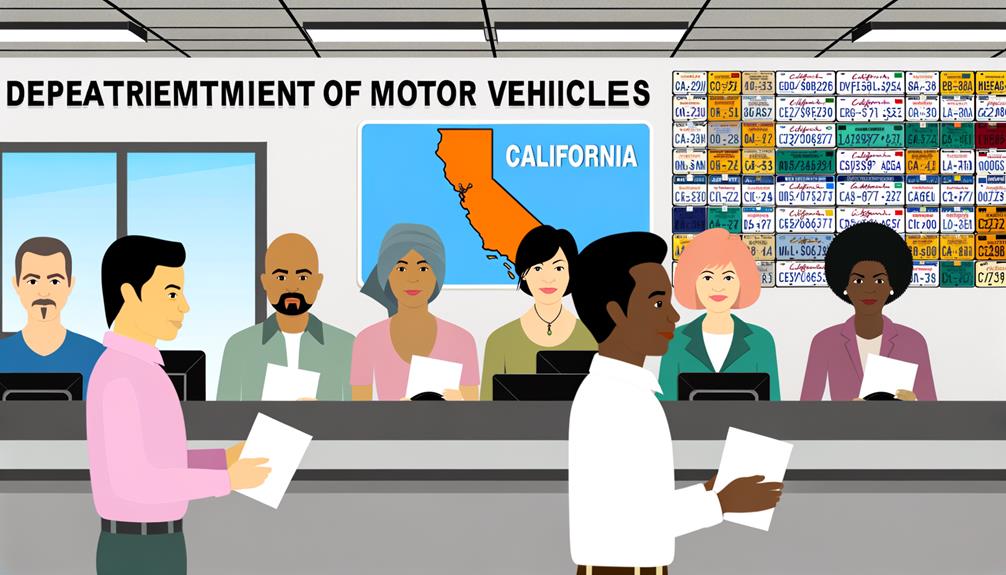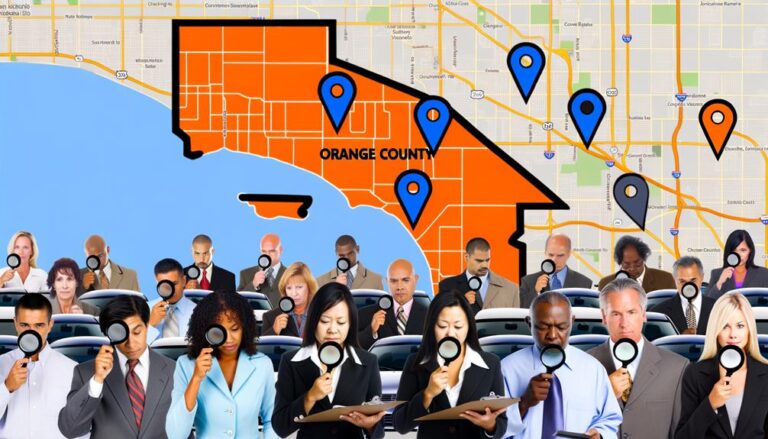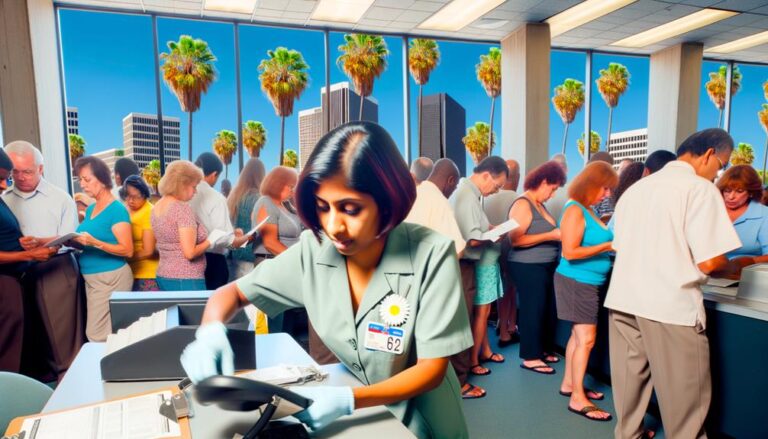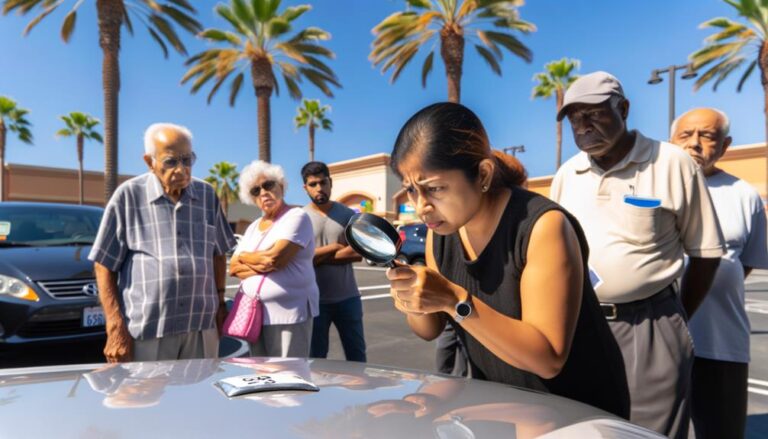To efficiently register your out-of-state vehicle in California, you'll need to act quickly and be well-prepared. Start by confirming your residency and ensuring your vehicle meets all emission standards, as outlined by the California Air Resources Board. You must register your vehicle within 20 days of establishing residency to avoid late fees. Gather essential documents like your out-of-state title, current registration, proof of California insurance, and a valid smog certificate for vehicles over four years old. Schedule your DMV appointment online to save time and check the fee calculator ahead of time to prepare the correct payment. Exploring further will provide deeper insights into smoothly navigating this process.
Understanding Eligibility Requirements
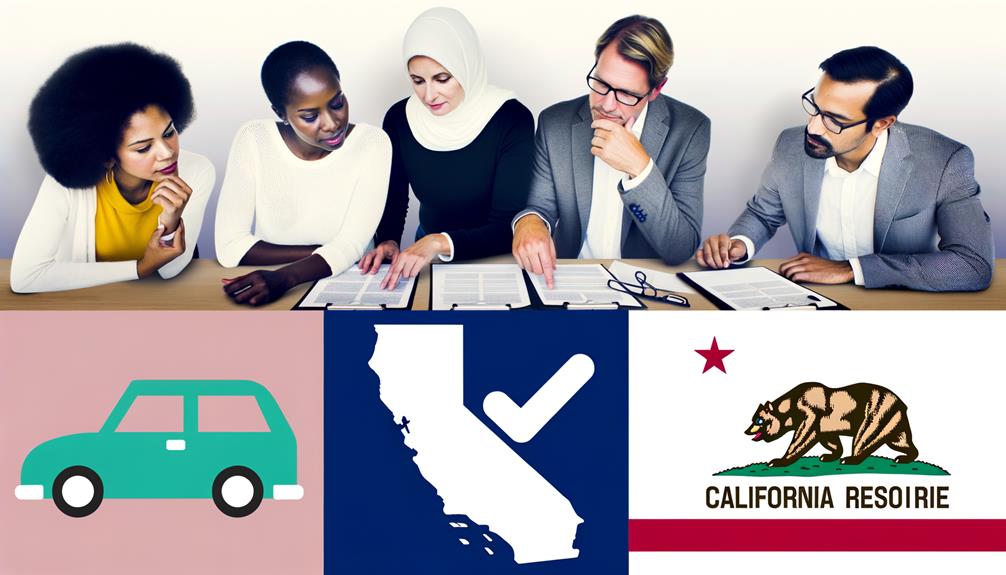
If you're planning to move to California or have recently settled here, it's crucial to register your out-of-state vehicle within 20 days to avoid late fees. Understanding the eligibility requirements is essential to ensure a smooth transition.
First, you'll need to establish your residency in California. This is vital as the California DMV requires proof of residency for vehicle registration. You'll be considered a resident once you start working in the state, claim tax exemptions as a resident, or rent or purchase a home.
Additionally, it's important to have your vehicle's VIN verified as part of the registration process, particularly if your vehicle is from out of state or has undergone significant modifications.
Next, check if your vehicle needs a smog certificate. Most vehicles more than four years old require this certification to help reduce pollution. However, certain vehicles, like hybrids and electric cars, might be exempt from this requirement.
It's best to verify directly with the California DMV or their official website to confirm if your vehicle falls under these exemptions.
Lastly, remember that your vehicle will undergo a physical inspection by the DMV, including a verification of the Vehicle Identification Number (VIN). This process confirms the vehicle's identity and integrity, ensuring all aspects meet California's standards before registration can be completed.
Gathering Required Documents
Before you visit your local DMV, it's crucial to gather all necessary documents to streamline your vehicle's registration process in California.
First, you'll need to complete the Application for Title or Registration (Form REG 343), which you can access online or at any DMV office. This form is foundational, outlining your intent to register the vehicle under California law.
Next, ensure you have your out-of-state vehicle title. This document is your proof of ownership and is indispensable for the registration process. Alongside the title, bring your current out-of-state registration to confirm the vehicle's legal status prior to its introduction to California.
For vehicles that are still under finance and lack a physical title, consider obtaining a Golden-Rod Title which allows you to register the vehicle under certain conditions without the standard title.
You must also provide a valid proof of insurance that meets or exceeds California's minimum liability coverage standards. This assures that your vehicle is covered under local regulations.
Lastly, don't forget to obtain a Smog Certificate from a certified inspection station, unless your vehicle falls into an exempt category. This certificate is a critical element, affirming that your vehicle meets California's emissions standards.
Each document plays a pivotal role in ensuring your registration endeavor is smooth and unimpeded, setting you up for a hassle-free experience at the DMV.
Emissions and Inspection Guidelines
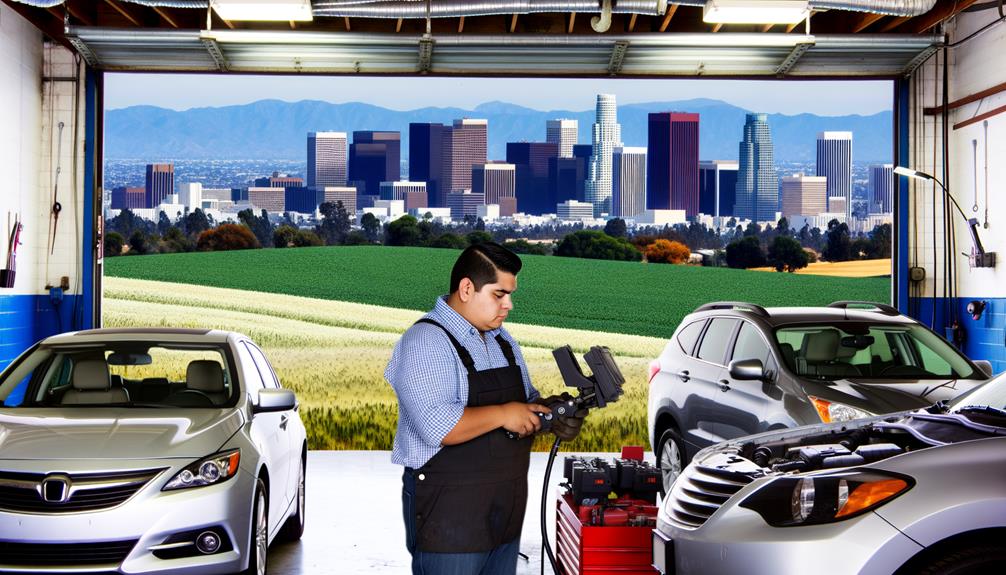
Navigating California's emissions and inspection guidelines is essential when registering your vehicle. If you're bringing an out-of-state vehicle into California, it must meet stringent emissions and safety standards. Here's what you need to know to ensure your vehicle complies and passes the necessary inspections.
Every out-of-state vehicle requires a smog inspection to verify compliance with California's emissions laws. This rule applies unless your vehicle is a hybrid, electric, or a gas-powered vehicle made before 1976.
For diesel vehicles, any model from 1998 onwards must pass a smog check; older models are exempt. Remember, new vehicles less than six years old aren't subjected to smog tests but incur a $20 smog abatement fee instead.
To avoid surprises, contact the California Air Resources Board (ARB) for precise requirements tailored to your vehicle's make and model. They can provide detailed guidance on necessary modifications if your vehicle doesn't initially meet California standards.
Compliance isn't just a legal formality; it's your contribution to maintaining California's air quality standards. Preparing adequately ensures you navigate this process smoothly, keeping your transition to California registration hassle-free and aligned with state laws.
Calculating Registration Fees
After ensuring your vehicle meets California's stringent emissions and inspection requirements, the next step is calculating your registration fees.
You'll want to navigate this carefully to avoid any surprises.
Here's what you need to factor in for an accurate estimate:
- Vehicle License Fee (VLF): This is calculated at 0.65% of your vehicle's market value. It's a significant part of your overall costs.
- Local Fees: Depending on where in California you register, expect additional fees ranging from $10 to $50.
- Smog Abatement Fee: For vehicles exempt from smog checks, there's a $20 fee.
Visit the California Department of Motor Vehicles website and use their fee calculator to get precise figures. This tool is crucial for obtaining accurate estimates and planning your budget accordingly.
Remember, the base registration fee typically starts around $60 but can vary significantly with your vehicle's specifics and your local area's regulations.
Including the sales tax, based on your vehicle's purchase price, in your calculations will also ensure you're fully prepared for the total cost.
Embrace this step to secure your freedom on California roads with no financial hitches.
Navigating DMV Appointments

Scheduling your DMV appointment online is a critical step in the vehicle registration process and can significantly reduce your wait time. By booking ahead, you'll streamline your efforts to register your vehicle, avoiding the frustration of long lines and wasted time.
Ensure you arrive at the DMV with all necessary documents: the out-of-state title, proof of insurance, and a valid smog certificate. These are essential to prevent any hiccups during your visit.
During your DMV appointment, the staff will conduct a VIN inspection to verify your vehicle's identification number. This step is crucial for securing your registration materials.
It's also wise to check in advance which payment methods your DMV location accepts to avoid any last-minute surprises.
Addressing Out-of-State Challenges
If you're bringing a vehicle from another state, registering it in California involves several critical steps. First, you'll need to have the original out-of-state title and registration. These documents are crucial as they prove ownership and previous registration status, which the local DMV office will require. Without them, you can't proceed with the registration process in California.
Next, if your vehicle is over four years old, securing a valid smog certificate from a certified California inspection station is essential. This step ensures your vehicle meets local emissions standards, which are stricter than many other states. Remember, compliance with the California Air Resources Board (ARB) regulations is non-negotiable.
Finally, be prepared for the registration fees. These are typically calculated based on your vehicle's market value and can range from $300 to $400, not including any applicable sales tax.
Here's a quick checklist to keep you on track:
- Ensure you have the out-of-state title and registration.
- Obtain a valid smog certificate if applicable.
- Prepare for the registration fees and have your vehicle ready for a VIN inspection.
Visit your nearest local DMV office with these items and your vehicle for the VIN inspection to complete your registration smoothly.
Avoiding Common Registration Errors
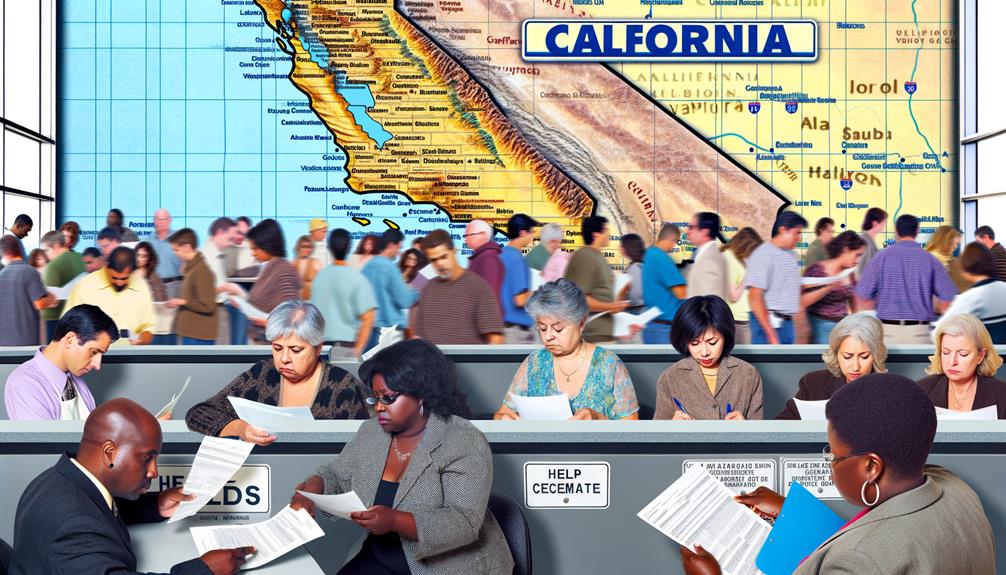
While managing your vehicle's registration in California, it's important to sidestep common pitfalls that can stall the process. First, gather all necessary documents including the out-of-state title, proof of insurance, and a completed Application for Title or Registration (Form REG 343) before you visit the DMV to avoid delays.
Ensuring every detail, especially your vehicle's VIN and registration details, is accurate and matches your documents is crucial. Any discrepancies can cause significant delays or complications.
Next, check that your smog certificate is current and valid. Many vehicles need a smog inspection completed within 90 days prior to registration. If you neglect this, you might face registration denial.
Also, be mindful of the 20-day registration window for new residents. Registering your car after this period incurs late fees. Scheduling your DMV appointment promptly can save you from unnecessary expenses.
Lastly, familiarize yourself with the specific registration fees for your vehicle type. Incorrect fee calculations can lead to underpayment, adding more hurdles to your registration process.
Special Considerations for Non-Residents
As you navigate the complexities of registering your vehicle in California as a non-resident, it's essential to understand the specific requirements and procedures that apply to you. When you aim to register a car as a non-resident, certain unique challenges arise that you must be ready to address.
Here are a few crucial points to consider:
- Required Documents: You'll need to provide a valid out-of-state title and registration, along with proof of insurance that meets California's minimum liability requirements.
- Emissions Compliance: Your vehicle must meet California emissions standards. Depending on your vehicle's age and type, a smog certificate from a certified inspection station might be necessary.
- DMV Inspection: Expect a physical inspection of your vehicle by the DMV, where they'll verify the VIN number to ensure it complies with all California regulations.
Understanding these steps will help you streamline the registration process and avoid unnecessary complications.
Complying With California Laws
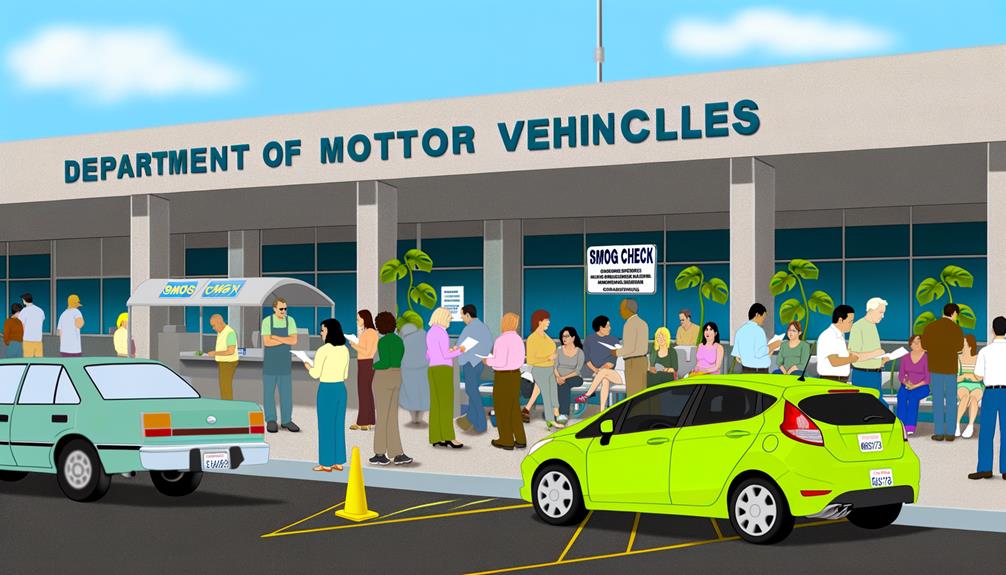
Navigating the process of registering an out-of-state vehicle in California demands strict adherence to state laws to ensure smooth, legal operation of your vehicle.
To start, you'll need to complete the Application for Title or Registration (Form REG 343). Don't forget to bring your out-of-state title and registration documents; these are essential for proving ownership and previous compliance.
You'll also need a valid smog certificate unless your vehicle is electric or fits specific older model exemptions. This step underscores California's commitment to maintaining high environmental standards. Make sure your vehicle meets these requirements to avoid setbacks in the registration process.
Insurance is another critical component. You must present proof of insurance that meets California's minimum liability requirements. This not only ensures compliance but also protects you financially in case of an accident.
Additionally, a VIN inspection conducted by the DMV is mandatory. This procedure verifies the identity of your vehicle and is crucial for confirming its compliance with California laws.
Finalizing Vehicle Registration
To finalize your vehicle's registration in California, gather all the necessary documents first.
You'll need a few key items to ensure a smooth process:
- Completed Application for Title or Registration (Form REG 343): This is essential to kickstart the registration.
- Proof of insurance and a valid smog certificate: Required for most vehicles to comply with state standards.
- Out-of-state title and registration: Verify your previous registration to transition smoothly.
During your DMV appointment, a VIN inspection is mandatory. This verifies your vehicle's identity and checks compliance with California standards.
Be ready to pay registration fees, which can vary between $300 to $400. Using the DMV's fee calculator ahead of your visit will give you an accurate estimate of the cost.
Frequently Asked Questions
What Do I Need to Do to Register My Out-Of-State Car in California?
To register your car in California, submit your registration documents and title transfer forms, meet smog requirements, and pay the fee structure. Don't forget to schedule an appointment for a VIN inspection.
Can I Drive in California While Waiting for Registration?
Yes, you can drive while waiting for registration if you meet DMV requirements, hold valid insurance, and your out-of-state registration is current. Ensure you understand temporary permits and vehicle inspection needs based on your residency status.
Can I Drive My Car in California if Its Registered in Another State?
Yes, you can drive your car in California with an out-of-state registration, but ensure you meet California laws, including insurance requirements, and consider temporary permits or vehicle inspections if staying long-term.
How Long Does CA Registration Processing Take?
CA registration processing usually takes 4-6 weeks, but delays can occur. Factors like incomplete forms or postal issues extend timelines. Online registration might be faster; ensure you've scheduled appointments and sorted your fee payment methods.

